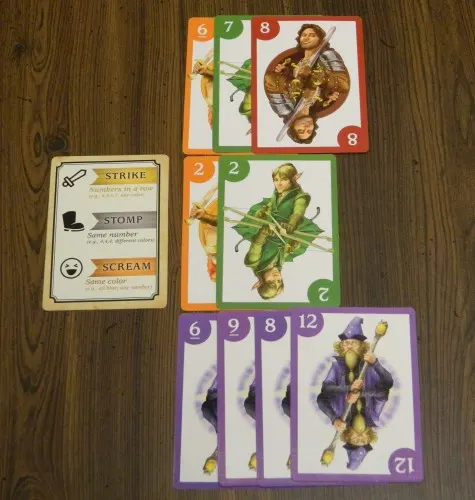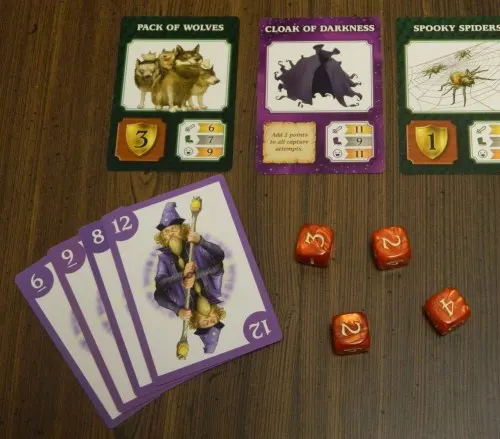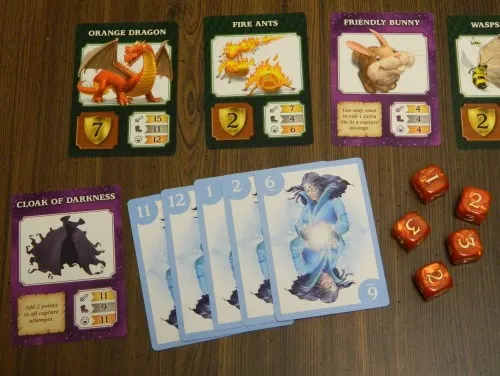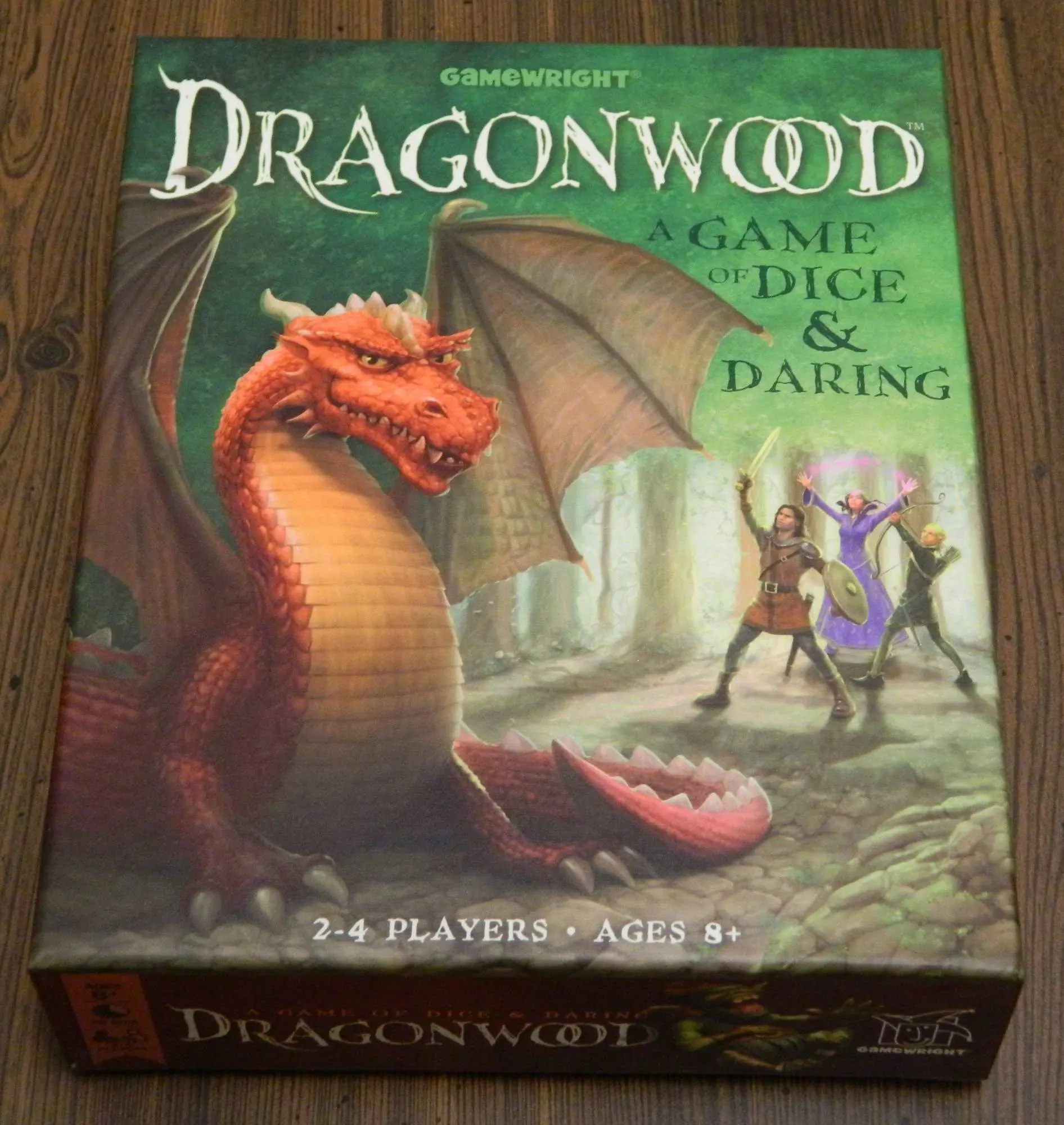How to Play
What Is Dragonwood and What Is the Objective of the Game?:
Dragonwood is a 2015 card and dice game from Gamewright that combines elements of set collection, dice rolling, and hand management. The object of the game is to collect and play sets of cards (either all of the same color or number or consecutive numbers) and use them to roll dice in an attempt to “capture” various creatures (which are worth victory points) and magical items (which can help you along the way but are worth zero victory points). At the end of the game (either when both dragons are captured or the deck has been played through twice), the player with the most victory points is the winner.
Setup:
To begin Dragonwood’s setup, remove the two turn summary cards from the deck and split the rest of the cards into two decks based on the color of the card back (you should have both a red adventurer deck and a green Dragonwood deck). The red adventurer deck is made up of five different suits, each numbered from 1 through 12, as well as four lucky ladybug cards. The green Dragonwood deck has three different types of cards: creatures, enhancements, and events. Find the two dragon cards (the orange dragon and the blue dragon) and remove them from the Dragonwood deck. Shuffle the rest of the deck and then randomly remove from play (put them back in the box) a number of cards based on the number of players in the game (2 players = 12 cards, 3 players = 10 cards, and 4 players = 8 cards). After you have removed these cards, take the bottom half of the Dragonwood deck and shuffle the two dragon cards into it. When you are done shuffling again, place these cards on the bottom of the other Dragonwood deck cards (this step is used to keep the dragons from appearing too soon in the game when nobody will be able to defeat them).
Reveal five cards from the Dragonwood deck and place them face up in the center of the table (these are the first creatures and enhancements you will try to capture). If any event cards (cards with an orange background) are revealed at this time, shuffle them back into the deck and draw new cards to replace them. Place the rest of this deck next to the five revealed cards. Now, shuffle the red adventurer deck and deal each player five cards (your hand is always kept secret from your opponents). Finally, put the rest of the adventurer deck and the six dice within easy reach of all players.
How to Play Dragonwood:
Dragonwood begins with the player who most recently hiked in the woods and play always continues to the left. Each turn, players have two options to pick from. They may either choose to reload (draw an adventurer card out of the red deck) or attempt to capture a creature or enhancement (by playing cards from their hand). If a player chooses to reload, they simply draw a card, add it to their hand, and indicate their turn is over by saying “Reload!” There is a nine card hand limit so if you have nine cards in your hand and you choose to reload you will have to discard either the new card or one already in your hand since you can’t have more than nine. If luck is on your side and you draw one of the four “lucky ladybug” cards, you immediately discard it and draw two more cards. If the adventurer deck runs out, shuffle the discard pile to start a new deck to draw from (once the deck has been gone through twice, the game is over).
Once a player has a few cards of the same color or number or a set of consecutive numbers (like 2, 3, 4, etc.) of any color, they may elect to try to capture one of the five cards on the table. There are three different ways to capture cards, you can strike (play consecutive number cards), stomp (play cards of the same number), or scream (play cards of the same color). You can play up to six cards that fit one of those criteria and each card that you play gives you one dice to roll. There are some situations where you can just play one card and still have a fighting chance to capture a creature (if you play just one card, you can pick whichever capture method you’d like). In order to capture cards, your roll must match or surpass the value printed on the card you are attempting to capture (strike is indicated by a sword, stomp by a boot, and scream by a screaming face).

These are examples of the different ways you can attempt to capture cards in Dragonwood. To strike, you must have cards of consecutive numbers. To stomp, you need cards of the same number. Finally, to scream you need cards of the same color. The first set would get the player three dice (one dice per card), the stomp two dice, and the scream four dice.
When you decide to try to capture a card, you do the following. First, you announce which creature or enhancement you are trying to capture and the way you are trying to capture them (for example, “I’m going to stomp on that Grumpy Troll”). You then show the cards you are using (including any enhancements which can add to your roll, though you can’t use them if you are attempting to capture another enhancement) and take one dice per card played. Finally, roll the dice and see if your roll meets or surpasses the required amount. If you have successfully captured a card, you take it and either keep it face up in front of you (if it is an enhancement) or add it to your “victory” pile face down (if it is a creature). Creatures are worth the amount of victory points indicated on the golden shield. If a card is captured, a new card from the Dragonwood deck replaces it (unless no more cards are left). This new card can now be captured (along with the other four that were already out there). The player who captured the card also discards any cards they used to do so (all of the cards they placed on the table except for their enhancements).

This player has decided to scream at the “Pack of Wolves” card (worth three victory points). Since they played four cards of the same color, they got to roll four dice. The Pack of Wolves’ scream value is nine, so their roll of thirteen is easily enough to capture it (it just needs to equal or surpass the value). This player will take the Pack of Wolves card, place it in their victory pile, and draw a new card to replace it on the table.
If you attempt to capture a card but fail, the penalty isn’t as severe as you would think. You put the adventurer cards you used in your attempt back into your hand and simply discard one card from your hand (it doesn’t even have to be one you used in the attempt). Whether you capture the card or not, your turn is over and play continues in the exact same way to the left.
Enhancements:
Enhancements are a very important component of the game even though they don’t give players any victory points for capturing them. This is because most of them help you throughout the rest of the game (there are some single use ones which are less useful). Some of the enhancements include “bucket of spinach” (add two points to all of your stomps for the rest of the game), “lucky mushroom” (re-roll any one die in all capture attempts), “lightning bolt” (allows you to add four points to any capture attempt but can only be used once), and the amazing “cloak of darkness” (add two points to all capture attempts for the rest of the game). As you can see, some of the enhancements are very strong and can make it much easier to capture cards.
Note: Enhancements can not be used to capture other enhancements, just creatures.
Event Cards:
There are a couple orange-backed cards in the Dragonwood deck. These cards’ effects occur immediately and affect all players. For example, the “sunny day” card lets all players draw two cards and the “wind storm” card forces all players to pass one adventurer card to their right. Once the event has been resolved, a new card is drawn from the Dragonwood deck to replace it on the table.
End Game:
Dragonwood ends when one of the two ending conditions is met. The game ends when either both dragons (the blue dragon and the orange dragon) have been captured or the adventure deck has been played through twice (shuffled once and then played through until no cards remain in the draw deck). If the second criteria is the one met, all players get one more turn before the game ends. Once one of these two criteria have been met, all players take their victory pile and add up the victory points their captured creatures gave them. They also count how many creature cards they captured and the player who captured the most gets three bonus victory points (if there is a tie, two victory points are awarded to every player in the tie). The player with the most victory points is the winner (if there is a tie, the player with the most captured creatures is the winner).

In this game, the blue dragon has already been captured. This player has decided to attempt to capture the orange dragon and end the game. They own the Cloak of Darkness enhancement (which adds two to all of their capture attempts) and elect to play five blue cards in an attempt to scream at the dragon. Their roll isn’t particularly good (eleven with five dice is below average) but the Cloak of Darkness allows them to surpass the dragon’s scream value and capture it. They put the card into their victory pile and the game is over (since both dragons have now been captured, which is one of the ending criteria).
Review
Very Quick and Easy to Learn and Play:
Like all of Gamewright’s games, Dragonwood is very easy to learn and play. It takes about five minutes to read through the instructions and it should be very easy to explain to all players (even if they are as young as eight). One of the best things about the game is that it is very elegant, there are some neat mechanics without there being a hundred different rules to memorize. You simply draw cards and look for “straights,” “flushes,” and pairs/three of a kind/etc. (to borrow poker terms). All of the cards you draw are effectively the same, they just gain more power if they happen to be the same color, number, or fit into a straight. The creatures are what change, they each have different defense values for each type of capture attempt. Some are a bit more vulnerable to strikes, others are weaker against screams, and so on.
In addition to being easy to learn and play, Dragonwood is also a very quick game. While your first game will likely take a bit longer than the twenty minutes listed on the box, future games should only take about that long (if not even less). Since the game is simple, players don’t spend a lot of time thinking about what to do so it tends to move very quickly. If you want Dragonwood to go a bit longer (maybe add five or ten more minutes to the game), it is pretty easy to customize the game to your liking. You can easily ignore the two times through the deck rule (though in our game this was pretty much a wash) and/or you can elect not to discard any cards out of the Dragonwood deck (adding 8-12 more creatures to capture). I ignored the two times through the deck rule in our first game (even though a player defeated the second dragon just after the deck was re-shuffled for the second time) and I plan to not discard as many (or maybe even any) Dragonwood deck cards the next time I play. It’s not that they are bad rules (they keep the game short which most people like), I just prefer longer games.
While I love hardcore strategy games as well, I do like a lot of these simple to learn games that still have interesting mechanics. They tend to get a lot of playtime in my household and I definitely see myself bringing Dragonwood to the table quite often. It is very good as a filler game, especially for families.
Family Friendly:
Gamewright is known for making games for families, some of which are mostly just for younger kids while others are fine for everyone in the family. Dragonwood is one of their games that everyone can enjoy. The game is very family-friendly (you “capture” creatures, you don’t harm or kill them) and any kid eight or older should be able to understand it. However, Dragonwood isn’t just a game for young kids, older kids (including teenagers) and even most adults should enjoy the game as well. This isn’t a game that is solely for kids that parents will dread having to play, they should have quite a bit of fun as well.
Heavy on Luck But Some Strategy As Well:
Since Dragonwood relies both on card drawing (luck of the draw) and dice rolling, it not surprisingly has a heavy luck component to it. However, there is definitely some strategy (and some very interesting decisions to make) to the game as well. In certain situations, you will want to play conservatively and make sure that only a terrible dice roll will prevent you from failing a capture attempt (this will cost you more cards though). Other times, it makes a lot of sense to take some calculated risks by playing just one or two cards (since the penalty is just discarding one card), especially if you have enhancements that help you out. There are even some situations where players will have a chance to capture a card almost for free (it will cost them just one card from their hand that doesn’t work with any other cards they have) but they might not actually take the offer because they need to hunt some bigger game. For example, all of the one victory point creatures have at least one weak spot where you only need a three to capture it. If you have an enhancement that gives you an extra two to your capture attempt, trying to capture one is automatic (since you will automatically roll the one you need) and will just cost you your least valuable card in your hand. However, you will have to decide whether that one victory point is worth a turn (and one card) or if you should try to capture something bigger and more valuable.
You are also given interesting decisions to make when enhancements are on the board during your turn. While you will have to spend multiple cards and enhancements don’t give you any victory points, a lot of them are worth the investment and will help you in future capture attempts. I would suggest always going for the enhancements which add to your roll (and some of the others) unless it is very late in the game. However, you also can’t spend the entire game going for enhancements because you need to capture enough creatures (and thus victory points) as well. One player in my game was dominating in enhancements. They had a +2 to all stomps, one that allowed them to re-roll one dice every capture attempt, and a one-use card that they were hoping to use against one of the dragons. We thought they had the game in the bag (you can’t see how many victory points a player has since they are placed face down after being captured) but they actually finished in last place, partially because they weren’t able to capture either dragon because they used a lot of their cards capturing enhancements.
While there is a lot of luck in Dragonwood, the game does a good job of limiting the luck factor. The biggest way the game does it is by modifying the typical six-sided dice into dice where the sides are weighted towards the middle (the sides are 1, 2, 2, 3, 3, 4 on each die) instead of simply being numbered one through six. You have a two-thirds chance of either rolling a two or a three on each dice and will only roll a “weak attack” (one) or “critical hit” (four) once per six rolls. Thus, you can pretty much count on getting two or three damage per dice you roll instead of any number from one to six. In addition, the game’s very small penalty for failing on a capture attempt encourages players to press their luck. If it doesn’t work, you simply discard a card and try again next turn. It really isn’t that big of a deal to fail capture attempts in this game, which is good because it keeps it from becoming too luck-based.
The only somewhat major problem with the game is that the order the creatures and enhancements come out matters quite a bit. If the great enhancements and high value creatures come out after you capture something else, you usually won’t even have a chance to capture them. The good enhancement cards were quickly scooped up in our game so if you have bad luck in this facet of the game, you will have a pretty significant disadvantage. Most likely all players will get a turn with a dragon on the board but there could be some situations where a player never even gets a chance to capture one (they both get captured before their turn comes up). Obviously there really isn’t any way to fix this but it is a slight issue with the game design and could actually wind up being the most important element of luck in the game.
Solid Components and Nice Art:
Overall, I liked the art in Dragonwood quite a bit. While some of the adventurer’s faces look a bit odd, the art is still overall drawn very well and fits the theme. Kids will especially love the art. As for components, the card stock is decent but not spectacular (since the game is very cheap I can excuse the average to slightly above average card stock). The custom dice, however, are very well done. They look very nice (and a bit whimsical) and definitely fit the theme.
Good Bang for Your Buck:
As an avid thrift store shopper who always looks for a good deal, it isn’t very often when I say this but I actually think Dragonwood might be slightly under-priced. The game sells for $15 but it seems more like a $20-25 dollar game to me. For $15, I think the game is a steal. If you like this type of game, this is the kind of game you will bring to the table very often and get a lot of plays out of. Since I play any game I’m interested in that I can find for a reasonable price, I rarely have the chance to go back and revisit games that I like. However, I have a feeling that I will be playing Dragonwood again very soon and many more times down the road.
Final Verdict
Dragonwood was a Mensa Select recipient this year and I can see why. While it is very simple to learn and play, the game still has a lot of interesting mechanics and decision making to it. I highly recommend Dragonwood for families who like this type of game. As for gamers who prefer strategy games, while this game does have a high amount of luck I still think a lot of hardcore gamers might actually enjoy it (as long as they like the occasional quick and easy filler game). I consider myself to be a hardcore gamer and I personally loved Dragonwood.


Kathryn
Saturday 19th of January 2019
I absolutely appreciate your review and thorough instructions. Thank you for taking the time to write such a lengthy set of instructions! Sadly, the game’s own instructions are fairly - uh - lackadaisical in not highlighting “step one,” “step two,” etc. Now that we know how to play the game, though, the game’s instructions make perfect sense, written in more of a storyline format. However, my family and I truly love his game and have you to thank! Really fun game. As soon as we call it a night and pack it up, we immediately start planning our next gaming adventure with Dragonwood.
Tonya
Monday 29th of May 2017
Really appreciate review and the in-depth instructions- cleared up a lot of misunderstandings I had. Your instructions are much better than the instructions which come with the game which I found somewhat lacking. Have enjoyed playing it much more since reading this page. Thank you!
LJ
Sunday 19th of February 2017
Excellent review. I am a hard core gamer, but love playing this game with my wife who is fairly new to gaming. It is easy to learn, while still requiring a lot of thinking as the game plays out. Love the game!